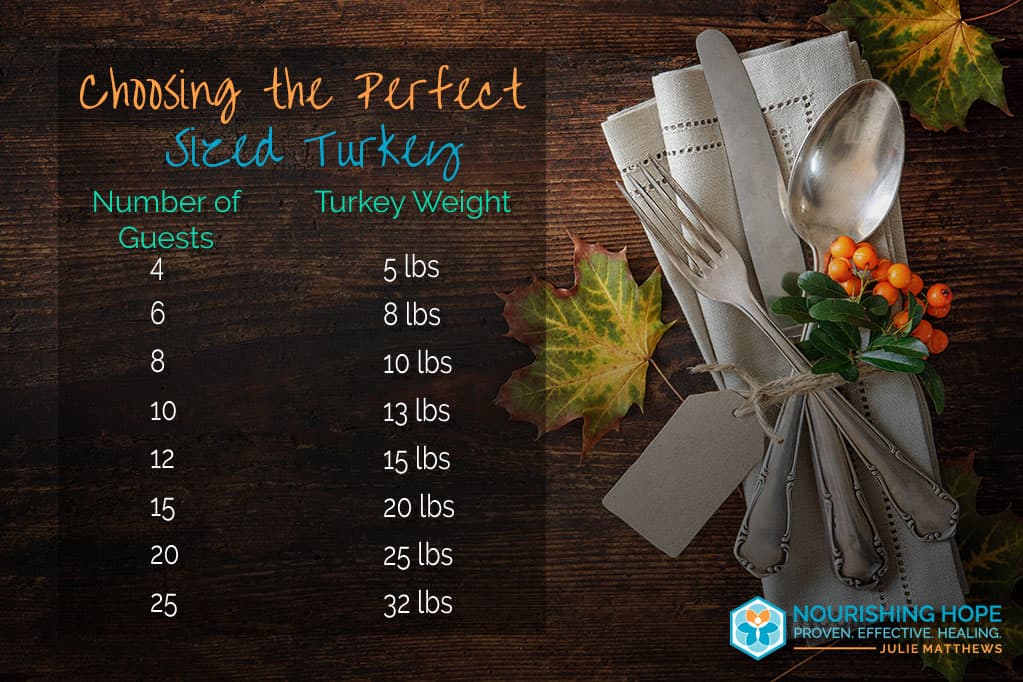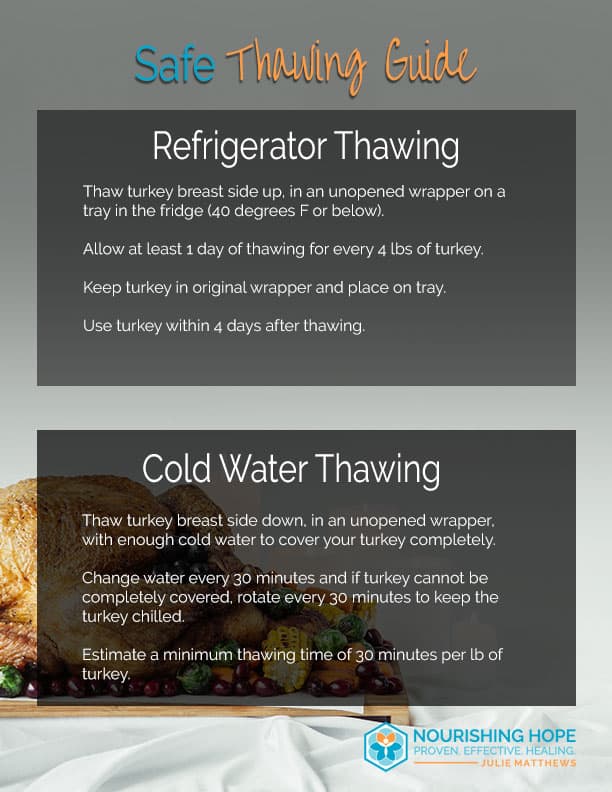The turkey is usually the star of your Thanksgiving show! Many traditional recipes can be converted for food allergies or intolerances. Here is an easy guide for a perfect bird!
Let’s start by discussing how much turkey you will need to buy and how to safely thaw it to get it ready to cook.
How Much Turkey Will You Need?
Number of Guests Turkey Weight
4 5lbs
6 8lbs
8 10lbs
10 13lbs
12 15lbs
15 20lbs
20 25lbs
25 32lbs

Ways to Thaw a Frozen Turkey
Turkey needs to be thawed before cooking. This is a really important concept, this is the major error many people make and the reason many turkeys are not cooked in time. For the best results, follow one of these thawing methods:
Refrigerator Thawing
- Thaw turkey breast side up, in an unopened wrapper on a tray in the fridge (40 degrees F or below).
- Allow at least 1 day of thawing for every 4 lbs of turkey.
- Keep turkey in original wrapper and place on tray.
- Use turkey within 4 days after thawing.
Cold Water Thawing
- Thaw turkey breast side down, in an unopened wrapper, with enough cold water to cover your turkey completely.
- Change water every 30 minutes and if turkey cannot be completely covered, rotate every 30 minutes to keep the turkey chilled.
- Estimate a minimum thawing time of 30 minutes per lb of turkey.

Roasted Turkey Recipe
Ingredients:
Turkey – weight depends on how many guests
½ cup expeller-pressed coconut oil
1 Tablespoon herbs d’provence or 1/2 Tablespoon dried sage & 1/2 Tablespoon dried thyme
2 teaspoons garlic powder
2-3 teaspoons salt
1 teaspoon ground black pepper
1 teaspoon salt
Instructions
Place turkey breast side up in a roasting pan. Melt 1/2 cup organic coconut oil and cover thawed turkey.
Add seasonings to your taste preferences, we love organic season salt, pepper love organic season salt, pepper and herbs de provence for a classic touch. Apply liberally.
Fresh rosemary and thyme sprigs can be inserted into the cavity can be inserted into the cavity
along with chopped onions, along with chopped onions, carrots, and celery for added flavor. Do not overstuff cavity.
Insert an oven-safe meat thermometer deep into the lower part of the thigh without touching the bone. When the thigh is up to temperature, and if the turkey is stuffed, move the thermometer to the center of the stuffing.
When the turkey is about done, loosely cover about done, loosely cover breast and top of drumsticks breast and top of drumsticks with a piece of foil to prevent overcooking. When you have verified adequate temperature verified adequate temperature has been reached, lift turkey onto platter, and let stand for 15 minutes before carving. Enjoy!
* Verify internal temperatures of at least 180 degrees Fahrenheit in the thigh and 170 degrees Fahrenheit in the breast.
For low salicylate, use sunflower oil and eliminate herbs and spices – use salt only, and you can rub a small amount of fresh garlic on turkey.
For low oxalate, eliminate black pepper, white pepper is an acceptable substitute.
For low FODMAPs, eliminate the garlic.
Turkey Cooking Times:
10 – 18 lbs 3 – 3 1/2 hours
18 – 22 lbs 3 1/2 – 4 hours
22 – 24 lbs 4 – 4 1/2 hours
24 – 29 lbs 4 1/2 – 5 hours
* Cooking times are for an unstuffed Turkey in a 350 degree Fahrenheit oven.
oven
10 servings
180 minutes




0 Comments